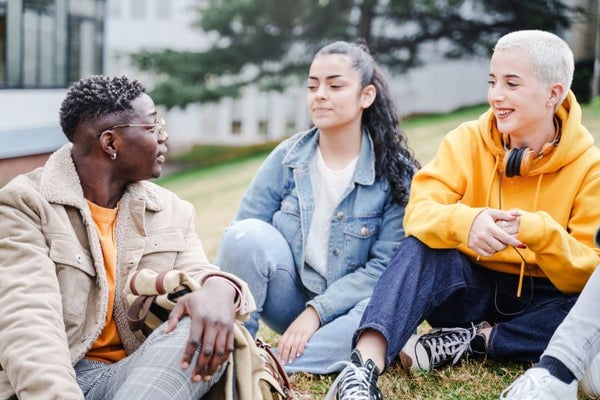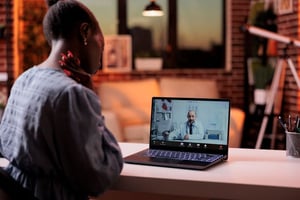4 min read The Importance of Listening Listening is vital for effective communication. It enables...
A Guide to Being Present in Conversations
5 min read
The Art of Listening: A Guide to Being Present in Conversations
In today's fast-paced and technology-driven world, it is easy to overlook the art of listening and underestimate its value. With constant distractions competing for our attention, genuine connections can often be disrupted! Ultimately, this is preventing us from fully engaging in meaningful conversations. But none of us want to make others feel like they are not listened to. So how can we get better at listening?
We will delve into the significance of the art of listening and offer practical tips on how to be a good listener. Drawing insights from the expertise of Soundwave, a provider of cutting-edge hearing solutions, we will explore the transformative power of active listening and how it can positively impact our relationships and interactions. Join us on this journey as we uncover the secrets to becoming proficient listeners and unlock the benefits of being fully present in our conversations.

Active Listening Techniques
It’s easy to sit back on your phone while someone is talking to you. We have all done it. But active listening involves employing specific techniques to enhance understanding and engagement. These techniques include paraphrasing to confirm understanding and reflecting on the speaker's emotions. By actively employing these techniques, we demonstrate our commitment to being present in the conversation, valuing the speaker's thoughts and feelings, and fostering effective communication.
Our Top Tip: Reflective Listening
Reflective listening involves paraphrasing or summarizing the speaker's message to demonstrate understanding and ensure accurate comprehension. It shows that you are actively engaged and processing the information. By restating the speaker's key points or reflecting on their emotions, you validate their perspective and encourage them to expand further on their thoughts.
Verbal Cues: How to Listen
Verbal cues are spoken responses or signals we provide during conversations. These cues are used to demonstrate our engagement, understanding, and active participation. They play a vital role in effective communication, conveying our attentiveness and support to the speaker. Verbal cues can take various forms, including affirmations, paraphrasing, open-ended questions, encouraging statements, prompts, and active affirmations. They help create an environment that encourages the speaker to share their thoughts and feelings more openly and allows for a deeper level of conversation.
By using verbal cues, we show that we are actively listening, processing the information, and seeking to understand the speaker's message. Verbal cues contribute to building stronger connections, fostering effective communication, and enhancing the overall quality of the conversation.

Non-Verbal Communication: The Power of Body Language
As we mentioned, not all communication comes through speech! Nonverbal cues include gestures, facial expressions, body language, and other nonverbal signals communicating meaning without using words. They play a vital role in communication, complementing spoken messages and adding depth to interactions. Nonverbal cues include facial expressions, body posture, eye contact, hand gestures, proximity, tone of voice, body movements, and touch.
These cues convey emotions, attitudes, engagement, and intentions. Nonverbal cues provide context, reinforce or contradict verbal communication, and contribute to a comprehensive understanding of the message being conveyed. Awareness of our nonverbal cues and attentiveness to those of others enhance communication and facilitate stronger connections. After all, if you aren’t paying attention, your nonverbal cues will probably let the other person know.
Cultivating Empathy Through Listening
Learning how to be a good listener involves understanding, connecting, and fostering empathy. When we truly listen, we create space for empathy, deepening our understanding, strengthening relationships, and building a compassionate world. Empathy begins with setting aside preconceived notions and immersing ourselves in the speaker's world. We suspend judgment, seeking to understand their thoughts, feelings, and experiences. By opening up to their reality, we validate their experiences, fostering genuine communication.
Furthermore, empathetic listening involves reflecting and responding to acknowledge the speaker's emotions and experiences. Validating their feelings, offering support, and asking open-ended questions show genuine interest and commitment. Cultivating empathy through listening strengthens bonds and fosters connection. It recognizes shared humanity, even among those with different backgrounds. Empathy fuels compassion, kindness, and understanding, creating positive change.
The Role of Patience and Practice
Becoming a skilled listener is an ongoing process that requires patience and practice. It involves being mindful of our listening habits, continually seeking improvement opportunities, and actively applying the techniques and strategies discussed. With time and dedication, the art of listening can become a natural and effortless part of our communication repertoire.
Overcoming Barriers to Listening
In our increasingly digital age, numerous barriers hinder effective listening. Maybe your phone just dinged. Maybe the music in the space you’re in is too loud. Maybe you can’t help checking if your spouse has texted. Digital distractions are everywhere. Beyond this, preconceived notions and personal biases can all impede our ability to listen and connect with others truly. Recognizing these barriers and consciously working to overcome them is essential to becoming a better listener.
But beyond this, you may be wondering how to listen because you’re facing hearing loss. Hearing loss is a prevalent condition that affects millions of people worldwide. Hearing loss has various causes, including age-related factors, exposure to loud noises, genetic predisposition, certain medical conditions, and ototoxic medications. It can range from mild to profound, affecting different frequencies and resulting in difficulties understanding speech, participating in conversations, and enjoying everyday sounds.
Fortunately, advancements in audiology and technology have provided solutions to manage hearing loss. Hearing aids, cochlear implants, and assistive listening devices can help individuals with hearing loss improve their auditory function and regain their ability to communicate effectively.

Be More Present With Soundwave
Soundwave is a revolutionary name in hearing aids! We offer innovative solutions to enhance your listening experience and help you be more present in conversations. Through cutting-edge technology and personalized approaches, Soundwave empowers individuals with hearing loss to engage in meaningful communication actively.
One of the key ways in which Soundwave facilitates being more present in conversations is through our advanced hearing aid technology. Our state-of-the-art self-fitting OTC hearing aids utilize sophisticated algorithms and features that optimize sound quality, amplify speech, and reduce background noise. By wearing these high-quality devices, individuals can regain clarity in their hearing and confidently participate in conversations.
Soundwave provides comprehensive resources and support to help users navigate their hearing journey effectively. They offer educational materials, tips for effective communication, and guidance on how to adapt to different listening environments. These resources empower individuals to proactively address communication challenges, fostering a sense of control and confidence.
By leveraging the offerings of Soundwave, individuals can overcome communication barriers, actively participate in conversations, and be more present in their interactions. Our commitment to cutting-edge technology, comprehensive support, and personalized care makes us an invaluable resource for individuals seeking to enhance their listening experience and reconnect with the world around them.



